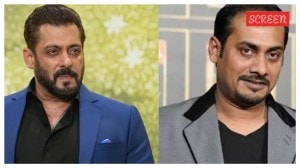Decode Politics: Himachal raises minimum age of marriage for women to 21, and why own party ‘surprised’
A Central proposal for this failed in the last Modi government, as Cong raised concerns, especially as regards Muslim personal law; Himachal BJP backs Sukhu govt’s move, calling it ‘technically our party’s law’
 The purpose of setting a minimum age is to outlaw child marriage. (Express photo by Nirmal Harindran/File)
The purpose of setting a minimum age is to outlaw child marriage. (Express photo by Nirmal Harindran/File)ON TUESDAY, the Congress government in Himachal Pradesh passed a law to raise the minimum age of marriage for women from 18 to 21 years. The legislation, Prohibition of Child Marriage (Himachal Pradesh Amendment) Act, 2024, which amended a 2006 provision, was passed unanimously, with the opposition BJP neither supporting or opposing it, and is set to override any personal laws or customs on the issue as regards people domiciled in the state.
A day later, Himachal Congress chief Pratibha Singh said she was taken by surprise at the Sukhvinder Singh Sukhu government’s move, given that the Congress had opposed a similar Bill by the Narendra Modi government at the Centre, mainly because of its implications for the Muslim personal law.
The Himachal BJP said it had very little reason to disagree with the legislation, as “it technically belongs to our party”.
* What is the Himachal government’s stand on the issue?
Presenting the Bill in the Himachal Pradesh Assembly Tuesday, Health, Social Justice and Empowerment Minister Dhaniram Shandil said: “(Raising) the marriage age (for women) would provide girls more opportunities to advance. Some girls still marry at a young age, which hinders their education and ability to progress in life. The government aims to (raise) the marriage age to protect individuals from malnutrition, as early marriages and motherhood often negatively impact health. Additionally, many women are unable to achieve success in their careers due to early marriage.”
* What are the provisions of the Prohibition of Child Marriage (Himachal Pradesh Amendment) Act, 2024?
The Act states that the new legislation amends the Prohibition of Child Marriage Act, 2006 – a Central law – and other related Acts in their application in Himachal, “to increase the minimum age for marriage for girls to 21 years”. It further states, “It (the law) shall apply to all persons domiciled in the territory of the State of Himachal Pradesh, notwithstanding anything contrary or inconsistent therewith contained in the Indian Christian Marriage Act, 1872; the Parsi Marriage and Divorce Act, 1936; the Muslim Personal Law (Shariat) Application Act, 1937; the Special Marriage Act, 1954; the Hindu Marriage Act, 1955; or any other law, custom, usage, or practice in relation to marriage under any other law for the time being in force.”
Section 5(iii) of The Hindu Marriage Act, 1955, sets a minimum age of 18 for the bride and 21 for the groom. This is the same for Christians under the Indian Christian Marriage Act, 1872, and the Special Marriage Act. For Muslims, the criterion is attaining puberty, which is assumed when the bride or groom turns 15.
* How large is Himachal’s minority population?
Himachal is a Hindu-majority state, with the community comprising 95.17% of the population. Muslims, who number around 1.50 lakh, make up 2.18% of the total. Other minority communities are equally small in numbers, including Sikhs (1.16%), Buddhists (1.15%), and Christians (0.18%).
Himachal has achieved a high rate of literacy at 82.80%, which is one indication of the gender parity in the state. Child marriages are uncommon.
* Do all Congress leaders support the move?
Himachal Congress chief Pratibha Singh claimed to The Indian Express that she was in the dark about the legislation. “I only found out today that this Bill was passed in the Vidhan Sabha.”
On the Congress’s opposition to a similar move by the Narendra Modi government at the Centre, Singh said: “Although I will not comment on the (Himachal) Act without reading it, the state Congress was not aware that any such Bill was being introduced by the Congress government in the Vidhan Sabha.”
* Why did the BJP support the Act?
Leader of the Opposition and former BJP CM Jairam Thakur said, “The Bill was originally introduced by the BJP government (at the Centre) in 2021. Although we are in opposition in the state, the Bill technically belongs to our party. We neither opposed nor supported it, which led to its unanimous passage.”
* What happened to the Centre’s proposal?
During his Independence Day speech in 2020, Prime Minister Narendra Modi first announced that the Centre had set up a committee to reconsider the minimum age of marriage for women. “The Centre will take a decision after the committee submits its report,” he said.
In 2021, the Union Cabinet cleared the proposal to raise the minimum age of marriage for women to 21. In December 2021, the Prohibition of Child Marriage (Amendment) Bill was introduced in the Lok Sabha.
Leader of the Opposition and senior Congress leader Adhir Ranjan Chowdhury said he was surprised at the government’s “haste” in pushing the move. “There have been no discussions with stakeholders. Members of minority communities have concerns about the Bill. The hurriedness reveals the government’s ulterior motives. It should be referred to a Standing Committee,” he said.
Congress MP Gaurav Gogoi, who is now the Deputy Leader in the Lok Sabha, had pointed out that a Law Commission report had recommended retaining 18 years as the uniform minimum age for marriage for women. “This (the Centre’s) Bill is going to affect all personal laws.”
The Bill was then referred to the Standing Committee on Education, Women, Children, Youth and Sports. With the dissolution of the last Lok Sabha, the Bill lapsed.
* What happens to the Himachal Act now?
First, it will be sent to Governor Shiv Pratap Shukla for his consent. Sources said no problem is expected as the legislation is in line with a Central proposal. A senior official with the Himachal Pradesh Social Justice and Empowerment Department said, “There will be necessary changes in personal laws.” However, changes in the Muslim law could raise significant legal issues.
Since the Himachal law is in conflict with the Central legislation on the issue, it will also require the President’s approval.
* What is the reasoning behind a minimum age for marriage?
The purpose of setting a minimum age is to outlaw child marriage. There are several legislation governing it, such as the Prohibition of Child Marriage Act, 2006, and the Protection of Children from Sexual Offences Act, 2012, or POCSO. Under the Child Marriage Prevention Act, any marriage below the prescribed age is illegal, and the perpetrators of a forced child marriage can be punished.
Social activists are opposed to raising the minimum age for marriage. Anita Sharma of the Himalayan Social Institute says: “It is a complicated issue. A lot of debate is still required. For example, such a law may be easy for the Himachal government to implement as women in the state usually marry at the age of 21-22. But what about states such as Bihar, Uttar Pradesh where women marry young? Here cases of eloping, live-in relationships may increase as couples won’t be able to marry legally. There may also be more cases of POCSO.”
A better way to raise awareness against child marriage is promoting education, Sharma adds.
* Why is the legal age of marriage different for men and women nationally?
There is no reasoning in the law for having different legal standards of age for men and women to marry. A Law Commission consultation paper argued that having different legal standards “contributes to the stereotype that wives must be younger than their husbands”.
Women’s rights activists have also said that the law perpetuates the stereotype that women are more mature than men of the same age and, therefore, can be allowed to marry sooner.
Photos



- 01
- 02
- 03
- 04
- 05



























